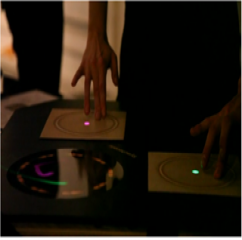Paragini Amin
Synchronic
Synchronic challenges people to synchronize their bodies using visual and audio feedback, as well as intuition, ultimately entering into a fluid, meditative state.
http://vimeo.com/17913609

Classes
Introduction to Computational Media,Introduction to Physical Computing
Introduction to Computational Media,Introduction to Physical Computing
Synchronic is a meditation tool. It is designed for people to enter a highly communicative state through simultaneous focus and relaxation. Whether operated by one person or two, the challenge is in syncing the movement of two hands on separate wooden plates in terms of direction, speed and pressure. A single user experiences heightened mind and body awareness as two brain hemispheres attempt to coordinate. With two users, each person becomes more aware of the other person's unspoken communication.
Users are instructed to perform a simple circular movement on separate plates. Hands in sync trigger a digital visual queue and sounds of harmonious Himalayan singing bowls. (A real bowl is played by applying pressure on its rim in a continuous circular motion with a wooden stick.)
Synchronic is also a new platform which can be further developed to incorporate more users and more intricate syncing challenges.
Audience
Mainly adults.
User Scenario
Two users sit next to each other at a table with headphones on. Each have a wooden plate with a circular track in front of them, onto which they are to trace a circle at the same speed and pressure as each other with one finger. As they begin asynchronous, they will hear distorted audio of Himalayan singing bowls. The audio will become more harmonious as their circles become more synchronized; and, conversely, more distorted if their circles become less synchronized.
In addition to the audio queue, a visual queue of a digital projection that corresponds to the users' finger positions will appear in between them.
At the height of the experience, the users' hands will be tracing in sync (or close enough) in circumference, speed, and pressure; the audio sounds will be at their most harmonious; and the digital display will become more intricate.
A similar user scenario would apply for a single user.
Implementation
Wood.
Conclusion
In research, I learned that human beings are highly capable of syncing their bodies fairly quickly. However, users of Synchronic take a little while to sync. Synchronic asks people to achieve sync using a physical interface that does not perfectly translate subtle body movement and intuition. Users are challenged to concentrate on learning the interface, and, at the same time, to relax and be open to their partner's signals. Single users are challenged to let both hemispheres of the brain communicate fluidly. When syncing does occur, the pay-off is delightful.
Users are instructed to perform a simple circular movement on separate plates. Hands in sync trigger a digital visual queue and sounds of harmonious Himalayan singing bowls. (A real bowl is played by applying pressure on its rim in a continuous circular motion with a wooden stick.)
Synchronic is also a new platform which can be further developed to incorporate more users and more intricate syncing challenges.
Audience
Mainly adults.
User Scenario
Two users sit next to each other at a table with headphones on. Each have a wooden plate with a circular track in front of them, onto which they are to trace a circle at the same speed and pressure as each other with one finger. As they begin asynchronous, they will hear distorted audio of Himalayan singing bowls. The audio will become more harmonious as their circles become more synchronized; and, conversely, more distorted if their circles become less synchronized.
In addition to the audio queue, a visual queue of a digital projection that corresponds to the users' finger positions will appear in between them.
At the height of the experience, the users' hands will be tracing in sync (or close enough) in circumference, speed, and pressure; the audio sounds will be at their most harmonious; and the digital display will become more intricate.
A similar user scenario would apply for a single user.
Implementation
Wood.
Conclusion
In research, I learned that human beings are highly capable of syncing their bodies fairly quickly. However, users of Synchronic take a little while to sync. Synchronic asks people to achieve sync using a physical interface that does not perfectly translate subtle body movement and intuition. Users are challenged to concentrate on learning the interface, and, at the same time, to relax and be open to their partner's signals. Single users are challenged to let both hemispheres of the brain communicate fluidly. When syncing does occur, the pay-off is delightful.

